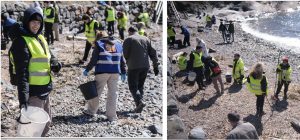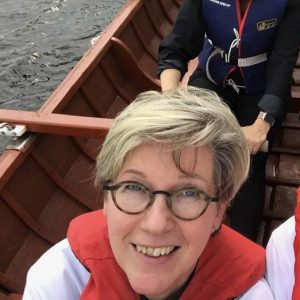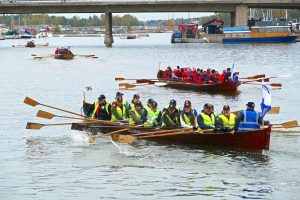By Ariel Miller, ESRAG Newsletter Editor
Through hands-on service and irresistible special events, Finnish Rotarians are expanding the ability of scientists to protect the Baltic Sea. Their work includes measuring and categorizing marine trash, monitoring blue algae blooms, and bringing a traditional Helsinki festival into the 21st century by adding environmental education and fundraising for environmental research.
ESRAG’s Finland Country Coordinator Liisa Stjernberg opened a window on this vital work by sending us a letter on the adventure three Finnish clubs are sharing as their citizen science defends the Baltic. Stjernberg, who served as District Governor in 2017-18, has long wanted to take action to protect the Baltic, and was overjoyed to find support from local clubs to launch this work in 2022.

Rotarians cheerfully picking up thousands of pieces of trash on the beach at Suomenlinna. Photo by Liisa Stjernberg
Three times a year a small team of Rotarians embark by boat to reach the narrow coastline under the Suomenlinna Fortress, a UNESCO World Heritage Site near Helsinki to collect, measure, and categorize marine trash, providing their observations to the Finnish Environment Institute (SYKE). The impact goes far beyond a morning’s clean-up.
“The statistics show that a great deal of the pollution comes from construction,” PDG Liisa reports. This includes waste from work on Helsinki’s Metro tunnels. “We have been talking to our Minister of Environment and the local government, telling them that they cannot continue to build housing and infrastructure like this,” says PDG Liisa. “Progress is slow, but we have evidence and they can’t deny it: we are counting the waste.
“Of course anyone can go to the shore and pick up litter. It’s not difficult,” she adds. “But our aim is to help the researchers. That’s the main point: that we can help the researcher to have this evidence for parliamentary members and local governments.”

PDG Liisa relishing a morning on the sea during Rotary’s Rowing for Baltic Herring event
“In Finland,” she explains wistfully, “we are so interested in having clear water in our seas and lakes. We love the clean air and want fine lakes and seas. The Baltic is quite polluted because it’s so shallow and has brackish water. Climate change is warming the water very fast. This is hurting the fishing industry. We are trying to prevent this harm and others, to make the losses transparent.”
“Citizen activity, such as that of the Rotary, greatly supports environmental research and monitoring,” says Sanna Suikkanen, Senior Research Scientist at SYKE. “Finland has a long coastline, and thus all help that citizens can provide to clean the beaches from marine litter or observe environmental conditions is warmly welcome.
“The type of detailed marine litter monitoring conducted by the Rotary makes it possible to get more specific estimates of the types, quantities and sources of marine litter close to the metropolitan area of Finland. The results are directly applicable and utilized for marine environment status assessments, as well as for designing and monitoring the effectiveness of actions to reduce littering.”
The Rotary team bring young people whenever possible, including Rotary exchange students. “The students are so glad they can participate,” PDG Liisa says. “Many exchange students have taken pictures of the cleanup and sent them to their home countries. They are so excited to do something that is valuable for their host country! It’s very important to teach children about pollution and what we can do.”

One of the Rotary crews during the Rowing for Baltic Herring fundraiser. Photo credit: Rowing for Baltic Herring
This waste monitoring work at Suomenlinna builds on a decade of increasingly successful Rotary fundraising to protect the region’s biodiversity. In 2013, Finnish clubs launched the Rowing for Baltic Herring event. It’s a new feature of the traditional regatta that opens Helsinki’s Baltic Herring Market on the first Sunday in October.
Sulkavan soutu, a Finnish rowing athletics federation, lends the Rotarians their longboats, with seats for 15 people (14 rowers and a cox). “The boats are called ‘Church boats’ for historical reasons,” PDG Liisa explains. “Centuries ago people rowed every Sunday to the churches in the Finnish countryside. Nowadays these boats are used for sports. Each Rotarian donates €80 for a seat, with Clubs sponsoring boats also. We always have boats for our exchange students, too.” A growing number of other people and organizations are contributing as well.
In just ten years this event has already raised over €75,000 for scientific equipment to monitor environmental conditions in this vulnerable, vital ecosystem.
Rowing for Baltic Herring also raises awareness. After the regatta, the teams come together to enjoy lunch and listen to a scientific talk. In 2020, when the Covid pandemic forced the cancellation of the regatta, Rotarians organized the first Herring Walk, a family-friendly event with fun activities along the path to learn about Baltic ecology. Adults contribute €60 and children come for free. The funds from the first Herring Walk provided a research grant enabling a student to complete her master’s thesis on the interaction of surface water and groundwater.
The scope of Rotary citizen science is growing! Over 70,000 Rotarians live in the nine nations bordering the Baltic Sea. In 2019, Rotarians worried about the critical threats to their ecosystem organized the multinational Baltic Sea Rotary Action Network (BASRAN) to join forces so they can more effectively advocate for the restoration and protection of the region’s biodiversity.
BASRAN volunteers from several countries are now monitoring blue algae blooms in lakes and sea weekly throughout the warmer months. They also organize conferences and webinars.
“Through the dedicated Rotary volunteers, we get information of the occurrence of cyanobacterial blooms in the summer season at a resolution that would never be possible by environmental authorities only,” says research scientist Sanna Suikkanen from the Finnish Environment Institute (SYKE).
“This project has a very good impact for cooperation within our District,” says PDG Liisa Stjernberg. “Many clubs have asked, ‘could we join you?’ The Institute can find other projects! You have to be brave and call the environmental institute in your area, and say, ‘Hello, I am a Rotarian.’ Don’t be shy, just make a phone call. I have noticed that nobody says ‘I’m not going to talk to you.’
“Littering is one of the global problems threatening the marine environment,” she points out. “We are a team of about ten persons. In two hours’ time we found over 2,000 items. Most of the items were construction waste, litter from boating, food packaging, foam rubber, bottle caps, plastic bags and ropes. Shock tube detonators and polymer fibre are a big problem on Suomenlinna beach. Maritime currents carry waste from snow dumps and the construction industry.
“Marine litter has many potential sources, as it is generated in the production, transport, use and destruction of materials, both on land and at sea. The amount of marine litter produced by a particular industry is difficult to estimate, as it is often hard to specify the source, route and geographical origin of individual pieces of litter.
“Rotarians in District 1420 are glad to clean the beach in Suomenlinna and help the Finnish Environmental Institute to identify the sources of litter. We are also glad to have very many exchange students with us and give them an opportunity to see what Rotary can do to save the Baltic Sea. We warmly encourage other Rotary clubs to contact their local environmental institutes and offer a helping hand to save our valuable nature and seas!”
Reach out to PDG Liisa Stjernberg if you’d like advice on launching partnerships between Rotarians and environmental organizations in your region.
